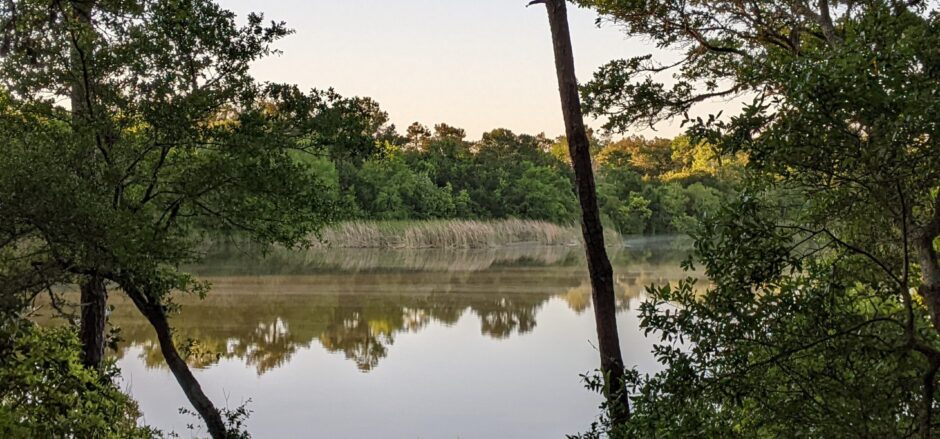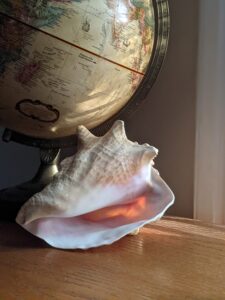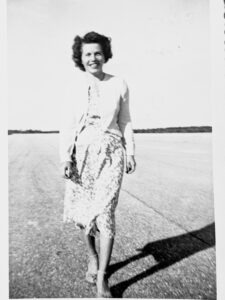For Wanda Keuning, 1924 – 2009 and Albert Siebe Keuning, 1954 – 1986
“I’d like the shell,” I told Robert. “Fine with me,” he shrugged. My brother has lived in Florida all his life, long ago lost interest in shells as decorative elements. At Mom’s without her, which felt strange, we read her instructions on what to do with everything. She had been thorough and efficient about it, as she was in life, as she had been in dying. For the most part, we did what she told us to do. That happened in July, twelve years ago.
I’ve lived in my Denver house decades longer than I ever lived anywhere else, am familiar with the sun’s annual journey around its rooms, the brief weeks it glares onto my lunch table, making reading difficult; the long weeks when it doesn’t enter the house until I’ve had the second cup of coffee. The July morning sun struck the shell, I stopped in my tracks. The globe and shell sit beside a northern window. To angle its way into that room, the sun must rise from the northern section of its eastern sky.
Charmed by the glowing shell, I paid no attention to the globe. If I’d noticed it, the way writers are supposed to notice significant details, I might have turned it a bit on its axis, revealed more of Africa, that cradle of human life, or at least a segment without a company list of cartographers slapped onto an empty swath of ocean. Hindsight: what you see when you look again, too late, over your shoulder.
In 1952 when we moved from Queens to Ft. Pierce, beachcombers still found an assortment of shells, but the conch shell would have been a rare find even then. Conches were harvested, had their dangerous spines and edges filed off and smoothed out, their mollusk exoskeleton identities erased. Even in the fifties, they were available mainly in shell shops on U.S. 1. Pandering to tourists resulted in conches being electrified as table lamps or glued to platforms dotted with miniature palm trees and hula girls.
In Florida I learned to be barefoot, collected shells obsessively those first years, when I was eight and nine. My interest faded, good shells became harder to find and who knows what became of the shoebox full of shells I cherished and then forgot.
Mom had lived in New York City all her life. She must have acquired this conch before the novelty wore off for her too. She made other touristy purchases—a shell ashtray, a shell-crusted lamp—but those disappeared over the years. This conch remained, long past the date when harvesting them became illegal. In Vero Beach it sat on a small metal bookcase that held her Reader’s Digest Condensed Books; in Starke on a credenza in the living room of her last home, an hour from the beach she’d long since stopped visiting.
I surprised myself, wanting the shell. There was little to want from that old mobile home. I piled clothes into two bundles: good enough for ARC or take to the dump and Robert delivered them. After she died it was a comfort that he and I worked well together, agreeing on the distribution of what there was to distribute. The conch shell sits on my own credenza next to the globe and a northern window—and recently caught the rays of the rising sun.
In this late 1953 or early 1954 photo, Mom was not yet thirty, still clung to her city habit of dress, had not converted. Eventually she went native like we all did, abandoned those ankle-strap, open-toe pumps for flip-flops, dresses for shorts, declared that she couldn’t take New York winters anymore. The Florida winter on this day was cool enough for a sweater. We were on that deserted Daytona runway so Robert could practice riding his bike without training wheels. He must have been five. I would have been nine. In this photo, Mom may have already been pregnant.
At eight or nine I had my own transition trauma to deal with: the kids who made fun of my accent, called me a damn yankee—a term I’d never heard before—and the mosquito bites on my legs that swelled and oozed. In hindsight, I suspect my mother was still ambivalent about Florida, about living in a trailer, and the vagabond life her husband imposed on her, but she was a faithful, uncomplaining wife, smiling as Dad took her picture.
We lived three more places in Florida after Ft. Pierce and Daytona, took the trailer to Long Island for the summer, before she told Dad that she and the kids couldn’t do this anymore and we settled in Vero Beach. By then I was thirteen, had winnowed New York out of my voice and Robert was a full-blown Floridian. Because she often said so, I do know Mom thought she was done having children before her last, surprise baby. And I do know that in the early fifties, she was briefly charmed by seashells.



Pat dear, a very nostalgic and touching account — you say so much with so few words. Thank you.
lots of love,
Winnie
Thanks, Winnie!
Isn’t it so cool when we notice anew something we’ve owned forever? I have those experiences now and then, the particular way the light hits an object or the memories it throws at you. Love these quiet stories, Pat!
Thanks, Deb. Yes, a random shaft of light can take you anywhere.
Ah, the light. Morning light through the east window, glowing through edges of jade tree leaves and yes, my favorite shell, finally finding my eyes and forcing me to close the shade a bit. Such moments attach so strongly to special places and things. Thanks, Pat.
Nice post.
On a related subject, the island in Maine I have been to since the 50’s has had a sad depletion of seashore life. In the news is the depletion of Casco Bay lobsters in the record-breaking warming of the Gulf of Maine.
But starting @three decades ago, I noticed the absence of the sea anenomes first, then, quickly, the sea urchins. The sea stars (starfish) which I thought would be there forever, like cockroaches, are now gone, too. Barnacles and seaweed: still there.
Visiting Vancouver Island years ago refreshed my memories of tidal pool life, but that memory will just be a memory soon.
Color me sad.
Shells, or their absence: yet another climate change indication. Your Maine island, one of many.
I love your story. It brought back a memory of my dad. He passed last year. My dad would go to the thrift stores, purchase the large shells, he then would drill a hole in them and put a Christmas bulb in them and they became nightlights. I totally forgot about that until your cuento. Thank you for reminding me of that beautiful story.
And I wonder if the thrift stores have shells now. What a sweet memory of your father. Glad I could help bring that back.
What you see when you look again: a beautiful reflection, Pat, as carefully spun as that shell. Thank you.
Thanks, Andrea, a careful spinner of words yourself!